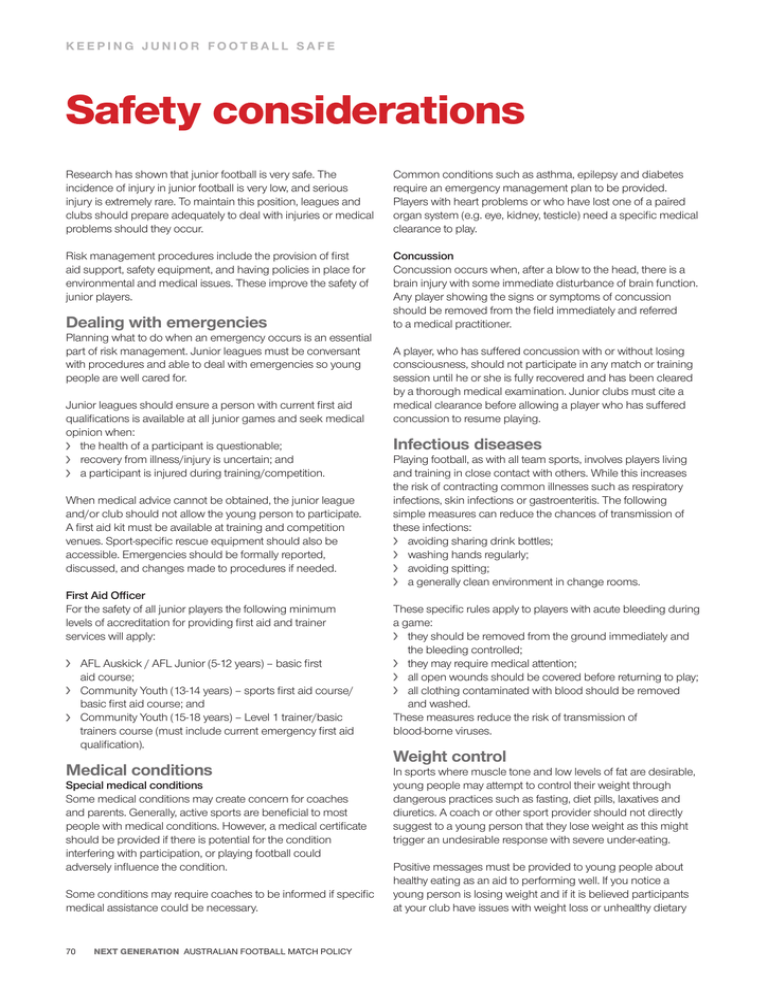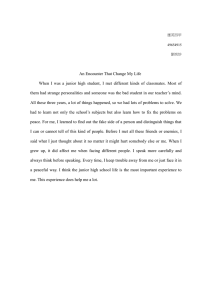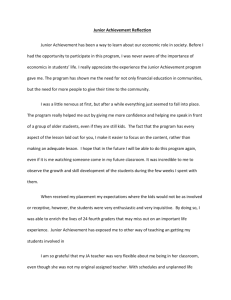Safety considerations
advertisement

KEEPING JUNIOR FOOTBALL SAFE Safety considerations Research has shown that junior football is very safe. The incidence of injury in junior football is very low, and serious injury is extremely rare. To maintain this position, leagues and clubs should prepare adequately to deal with injuries or medical problems should they occur. Common conditions such as asthma, epilepsy and diabetes require an emergency management plan to be provided. Players with heart problems or who have lost one of a paired organ system (e.g. eye, kidney, testicle) need a specific medical clearance to play. Risk management procedures include the provision of first aid support, safety equipment, and having policies in place for environmental and medical issues. These improve the safety of junior players. Concussion Concussion occurs when, after a blow to the head, there is a brain injury with some immediate disturbance of brain function. Any player showing the signs or symptoms of concussion should be removed from the field immediately and referred to a medical practitioner. Dealing with emergencies Planning what to do when an emergency occurs is an essential part of risk management. Junior leagues must be conversant with procedures and able to deal with emergencies so young people are well cared for. Junior leagues should ensure a person with current first aid qualifications is available at all junior games and seek medical opinion when: the health of a participant is questionable; recovery from illness/injury is uncertain; and a participant is injured during training/competition. When medical advice cannot be obtained, the junior league and/or club should not allow the young person to participate. A first aid kit must be available at training and competition venues. Sport-specific rescue equipment should also be accessible. Emergencies should be formally reported, discussed, and changes made to procedures if needed. First Aid Officer For the safety of all junior players the following minimum levels of accreditation for providing first aid and trainer services will apply: AFL Auskick / AFL Junior (5-12 years) – basic first aid course; Community Youth (13-14 years) – sports first aid course/ basic first aid course; and Community Youth (15-18 years) – Level 1 trainer/basic trainers course (must include current emergency first aid qualification). Medical conditions Special medical conditions Some medical conditions may create concern for coaches and parents. Generally, active sports are beneficial to most people with medical conditions. However, a medical certificate should be provided if there is potential for the condition interfering with participation, or playing football could adversely influence the condition. Some conditions may require coaches to be informed if specific medical assistance could be necessary. 70 NEXT GENERATION AUSTRALIAN FOOTBALL MATCH POLICY A player, who has suffered concussion with or without losing consciousness, should not participate in any match or training session until he or she is fully recovered and has been cleared by a thorough medical examination. Junior clubs must cite a medical clearance before allowing a player who has suffered concussion to resume playing. Infectious diseases Playing football, as with all team sports, involves players living and training in close contact with others. While this increases the risk of contracting common illnesses such as respiratory infections, skin infections or gastroenteritis. The following simple measures can reduce the chances of transmission of these infections: avoiding sharing drink bottles; washing hands regularly; avoiding spitting; a generally clean environment in change rooms. These specific rules apply to players with acute bleeding during a game: they should be removed from the ground immediately and the bleeding controlled; they may require medical attention; all open wounds should be covered before returning to play; all clothing contaminated with blood should be removed and washed. These measures reduce the risk of transmission of blood-borne viruses. Weight control In sports where muscle tone and low levels of fat are desirable, young people may attempt to control their weight through dangerous practices such as fasting, diet pills, laxatives and diuretics. A coach or other sport provider should not directly suggest to a young person that they lose weight as this might trigger an undesirable response with severe under-eating. Positive messages must be provided to young people about healthy eating as an aid to performing well. If you notice a young person is losing weight and if it is believed participants at your club have issues with weight loss or unhealthy dietary KEEPING JUNIOR FOOTBALL SAFE practices, act promptly; they should be referred to appropriate health providers for assistance. Facilities and equipment Boundary line In order to prevent injuries to players, officials and spectators, the distance between the boundary line and oval fencing should be a minimum of 3 metres. Goal-post padding In order to prevent injuries to players, officials and spectators, all fixed goal and behind posts must be padded as follows: a minimum of 35 millimetres thick foam padding, covered in canvas or painted; a minimum height of 2.5 metres from the bottom of each goal and behind post; a suitable width to allow the padding to be fixed around each goal and behind post; and The padding must be securely attached around each goal and behind post. Mouth guards It is recommended all children participating in any form of the game should wear an appropriately fitted mouth guard. Protective head gear (helmets) There is no strong evidence to suggest protective head gear is necessary in junior football. In the event that protective head gear (a helmet) is required because of a disability or medical condition, a medical certificate should be provided that states the protective head gear will provide adequate protection. Spectacles Junior footballers who wish to wear spectacles during matches and training sessions should wear spectacles with plastic frames and plastic lenses. A band must also hold the spectacles on securely. This will minimise the risk of injury to the player, teammates and opposition players. NEXT GENERATION AUSTRALIAN FOOTBALL MATCH POLICY 71


